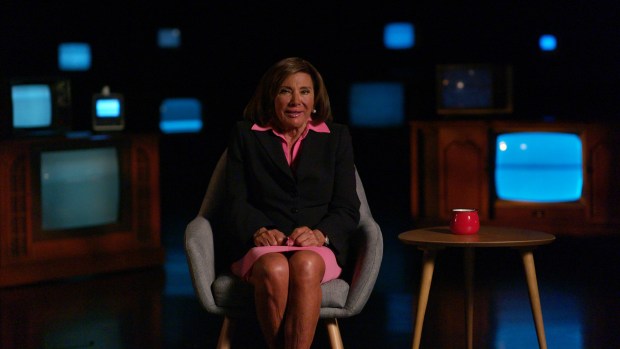There’s an old joke that as the Twin Cities don’t have a whole lot of actual celebrities, local television news anchors and reporters end up playing the part. And, well, one of the many takeaways of the fascinating new documentary “Broadcast Wars” is that, at least at one time, that’s wasn’t really a joke.
Produced by Twin Cities PBS, “Broadcast Wars” explores the history and heyday of local broadcast news, when stations used everything from new technology to sex appeal in the battle for ratings. The documentary blends vintage footage with contemporary interviews with folks like Don Shelby, Cyndy Brucato and Paul Douglas.
“The Twin Cities were at the center of a media revolution, and the battles for ratings weren’t just about who had the best newscast — they were about how we told the stories of our community,” said co-executive producer Cathy Wurzer. “The innovations of that time set the stage for the way we consume news today, and I’m excited for audiences to see the impact these legendary figures had on both television and our civic life.”
“Broadcast Wars” airs at 7 p.m. Nov. 26 on TPT 2 and will stream as a three-part docuseries on the PBS app. As a preview, here are some tidbits from the series about the early days of Twin Cities newscasts.
- Red Wing native Stanley Eugene Hubbard, according to Wurzer, “was largely responsible for the birth of commercial radio in Minnesota.” He built the first radio station that survived on the sale of advertising anywhere in the country. About 10 years after KSTP radio began airing, Hubbard bought the very first television camera, made by RCA, and used radio station profits to get a television station up and running.
- KSTP TV went live on April 27, 1948, and offered some of the first newscasts in the country. Initially, the news only aired on Mondays. Daily 10 p.m. newscasts began in the early ’50s. Hubbard himself sometimes covered breaking news.
- In order to compete with KSTP, WCCO hired consultants to help develop what would become “The Scene Tonight,” which debuted on Jan. 8, 1968, with anchors Dave Moore, Bud Kraehling, Hal Scott and Skip Loescher. It was the area’s first 45-minute 10 p.m. newscast, and the station used the length and format to try new innovations.
- Wurzer said Moore was “a Minneapolis native who was destined to become a Minnesota icon.” Hubbard Broadcasting chairman and CEO Stanley S. Hubbard called Moore terrific: “(He) came across as a wonderful ‘I’m one of you’ (guy). He was good, unfortunately.” Cyndy Brucato, a WCCO reporter in the late ’70s, said she loved Moore and tried to write in his voice: “That’s how I learned to write good TV news copy … He was so good and yet he wasn’t a newsman and he was the first to tell you he wasn’t a newsman.”

- To compete with “The Scene Tonight,” KSTP pioneered a dual anchor model, pairing John MacDougall with another anchorman, Bob Ryan.
- Around that time, weathermen began to show more personality on the air, including P.J. Hoff at KSTP. Hoff was a columnist and cartoonist for the St. Paul Dispatch and he’d have a big sketch pad and a marker to illustrate the forecast. Kraehling at WCCO was the first in the market to use weather radar.
- In order to, as Wurzer put it, “add a little sex appeal to their newscasts,” WCCO employed the first weather girl, Nancy Nelson, in the ’60s. In 1969, WTCN (which would later become KARE) hired the first Black weather girl in the market, Toni Hughes.
- Marcia Fluer became a KSTP reporter in 1972 and went on to become one of the first female anchors in the Twin Cities. “When I walked into KSTP, there was no woman ever in the newsroom who had ever been allowed to anchor, even the early morning show,” Fluer said. “There had been no woman in the newsroom who had been able to cover fires, and murders, and certainly not politics. … I just sucked it up, learned the business, learned the culture, put both feet down on the ground, and stayed there for 13 years.”
- Then-WCCO news director Ron Handberg said everyone in the newsroom smoked in those days and the low ceilings made it a challenging work space. “The smoke in the basement was so thick, you actually had to squint to see who was sitting at the desk,” said anchor Pat Miles. “Everybody smoked, everybody. We chain smoked. We didn’t just smoke, we chain smoked. There was no ventilation.”

- Actual meteorologists began showing up on local stations in the ’70s. “A couple of very visionary general managers in weather-sensitive markets tried out putting actual degreed meteorologists on the air,” said longtime meteorologist Paul Douglas. “And viewers seemed to like it because they could actually explain what was going on and why.”
- In the ’70s, competition between the stations led to further use of consultants, who shaped the look and feel of newscasts for decades to come. “They used audience research that led to these fast paced, flashy news formats, action news or eyewitness news, the happy talk banter between anchors, the emphasis on good-looking anchors, dramatic graphics, the slick set designs. They really changed the face of local TV news,” Wurzer said.
[embedded content]
Originally Published: November 20, 2024 at 10:19 PM CST
